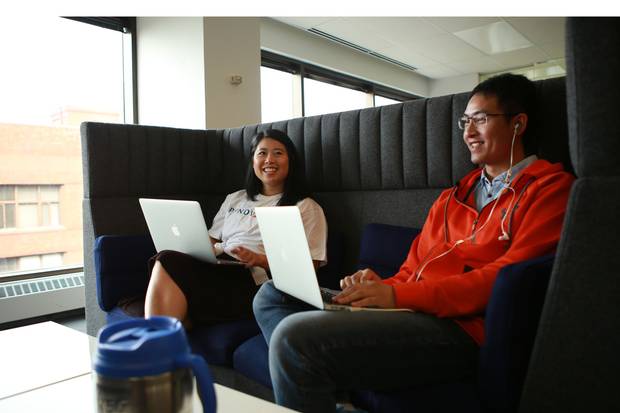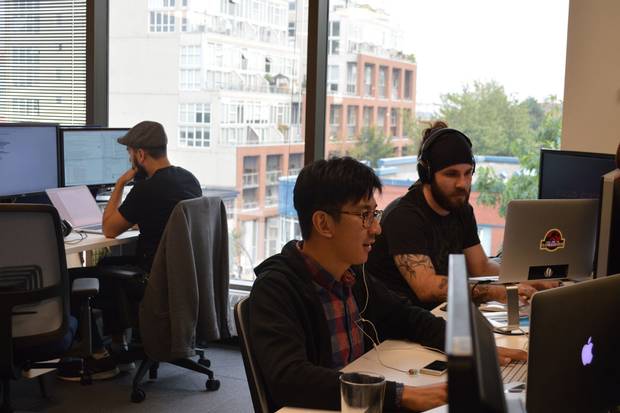The series: We look at decision makers among Canada's mid-sized companies who took successful action in a competitive global digital economy.
Arnold Leung founded Appnovation Technologies at 22 after graduating from university in 2007. Today, the company has 15 global offices and about 250 employees. But it got there in a way that experts say can be treacherous to navigate.
Read related: It doesn't matter if it's a good idea if the timing's not right
Since its founding, the company – a provider of open-source technology for app and website development and management – has built a sizable roster of recognizable partners around the world, including Maple Leaf Sports & Entertainment (MLSE), owner of both the Toronto Raptors basketball and the Maple Leafs hockey teams. MLSE needed a better way to connect to and engage with its fan base, particularly Leafs fans. Using an open-source content management system called Drupal, Appnovation designed a faster, more accurate site for Leafs Nation.

“It’s always been our strategy to be a global company, so we’re always following a road map to expansion,” explains Appnovation’s head, Arnold Leung. “And we find that acquisition is a faster route to global expansion rather than organic growth.”
Harry Ma/Appnovation
The Vancouver-based tech company now has offices globally, including in the United States, Britain and Hong Kong. But in early 2016, Mr. Leung and his team set their eyes on mainland Europe and knew that they would have to think big if they wanted to break into such a large market. This meant acquiring a company that was already established in their target market and diving into the world of global acquisitions.
"It's always been our strategy to be a global company, so we're always following a road map to expansion," explains Mr. Leung. "And we find that acquisition is a faster route to global expansion rather than organic growth."
After nine months of planning, Appnovation announced its first acquisition with Wunderkraut Benelux (made up of Wunderkraut Belgium and Wunderkraut Netherlands) – also a provider of the content management system Drupal – with an established client base and talent throughout Europe. The match made sense for a multitude of reasons, explains Mr. Leung.

Michelle Alphonso, managing director, transactions and national transaction advisory services leader at Grant Thornton LLP (Canada): “When you have two different teams coming together, there might be cultural differences or the processes are different, so if you’re not on stable ground yourself, it becomes very hard to guide the second company through a proper integration process.”
Grant Thornton
The acquisition brought Appnovation employee numbers from 85 to about 250.
"We wanted to enter into the European market and we believed that Belgium and Netherlands would be the perfect choices to begin with, as these markets have a high percentage of English speakers," says Mr. Leung. "We were looking at other companies too, but this company had an amazing portfolio of customers with leading companies …and amazing people, so it made sense for us."
Indeed, acquisitions are tricky strategies to navigate, with many looking good on paper, but their realities can be disastrous and costly. Between 70 to 90 per cent of mergers and acquisitions fail, according to the Harvard Business Review.
And even if a merger does take place, it is often difficult to integrate two companies under one common corporate goal. What makes the situation even more complex – particularly on a global scale – is the merging of two sets of employees with different cultures, work habits, personalities and skillsets.
![Andreas Schotter, professor of international business, specializing in global strategy, at the University of Western Ontario’s Ivey Business School: “When acquisitions fail it usually comes down to poor acquisition target, [failure] of the post-acquisition integration team, and perhaps the worst … the inability to walk away from the deal.”](https://www.theglobeandmail.com/ece-images/104/report-on-business/article37176021.ece/BINARY/w620/SchotterWEB.jpg)
Andreas Schotter, professor of international business, specializing in global strategy, at the University of Western Ontario’s Ivey Business School: “When acquisitions fail it usually comes down to poor acquisition target, [failure] of the post-acquisition integration team, and perhaps the worst … the inability to walk away from the deal.”
Shawn Simpson/Ivey
Without a clear acquisition strategy in hand, an acquisition will struggle to make it to the finish line, explains Michelle Alphonso, managing director, transactions and national transaction advisory services leader at Grant Thornton LLP (Canada).
"We advise our clients to make sure that they are standing on stable ground before pursuing an acquisition," she explains. "When you're taking two businesses and trying to amalgamate them and merge them together, there is a lot of value that can be lost in that process. When you have two different teams coming together, there might be cultural differences or the processes are different, so if you're not on stable ground yourself, it becomes very hard to guide the second company through a proper integration process."
It is not only necessary to know what the company wants to achieve through the act of acquisition (for instance, growing globally), "But also how big an acquisition you can make, how you are going to financially support an acquisition, and who are the people you want to protect through the process," says Ms. Alphonso.
A recent study by KPMG reports that only about a third of mergers, acquisitions and takeovers in North America "add value," and about 70 per cent actually reduce shareholder worth, with 66 per cent of the reduction occurring "after the two sides had reached an understanding."
Andreas Schotter is a professor of international business, specializing in global strategy, at the University of Western Ontario's Ivey Business School and says when companies consider a global acquisition there can never be a point when the company is not willing to walk away.
"When acquisitions fail it usually comes down to poor acquisition target, [failure] of the post-acquisition integration team, and perhaps the worst … the inability to walk away from the deal."
And it is much harder than people might think. Acquisitions take time – months, years even – and sometimes companies can get into situations where the amount of time they have spent putting a deal together becomes a major factor in the deal-making process.

Appnovation’s head says the company has found its perfect partner and has taken several steps to ensure its post-acquisition era goes smoothly. This includes the creation of a centralized marketing function and its support maintenance team, “so that our customers and team members can access support around the world,” says Appnovation’s head, Arnold Leung.
Appnovation
"It almost becomes past-dependent on the time spent on this acquisition … and you end up agreeing to a deal, which is really something that you should walk away from."
But Appnovation's head says the company has found its perfect partner and has taken several steps to ensure its post-acquisition era goes smoothly. This includes the creation of a centralized marketing function and its support maintenance team, "so that our customers and team members can access support around the world," says Mr. Leung.
As for the future of Appnovation, "We're definitely open to other acquisition opportunities as they come up."
MORE FROM THE SERIES:

/arc-anglerfish-tgam-prod-tgam.s3.amazonaws.com/public/YGOVFZGOUNBHNLBZSEU33RB5LI.JPG)
/arc-anglerfish-tgam-prod-tgam.s3.amazonaws.com/public/FZRO6K62Z5EOFEFQCCIISZXG7Y.jpg)
/arc-anglerfish-tgam-prod-tgam.s3.amazonaws.com/public/OQQU6S5IMZHF3HEKRMQJ4L4HFI.JPG)